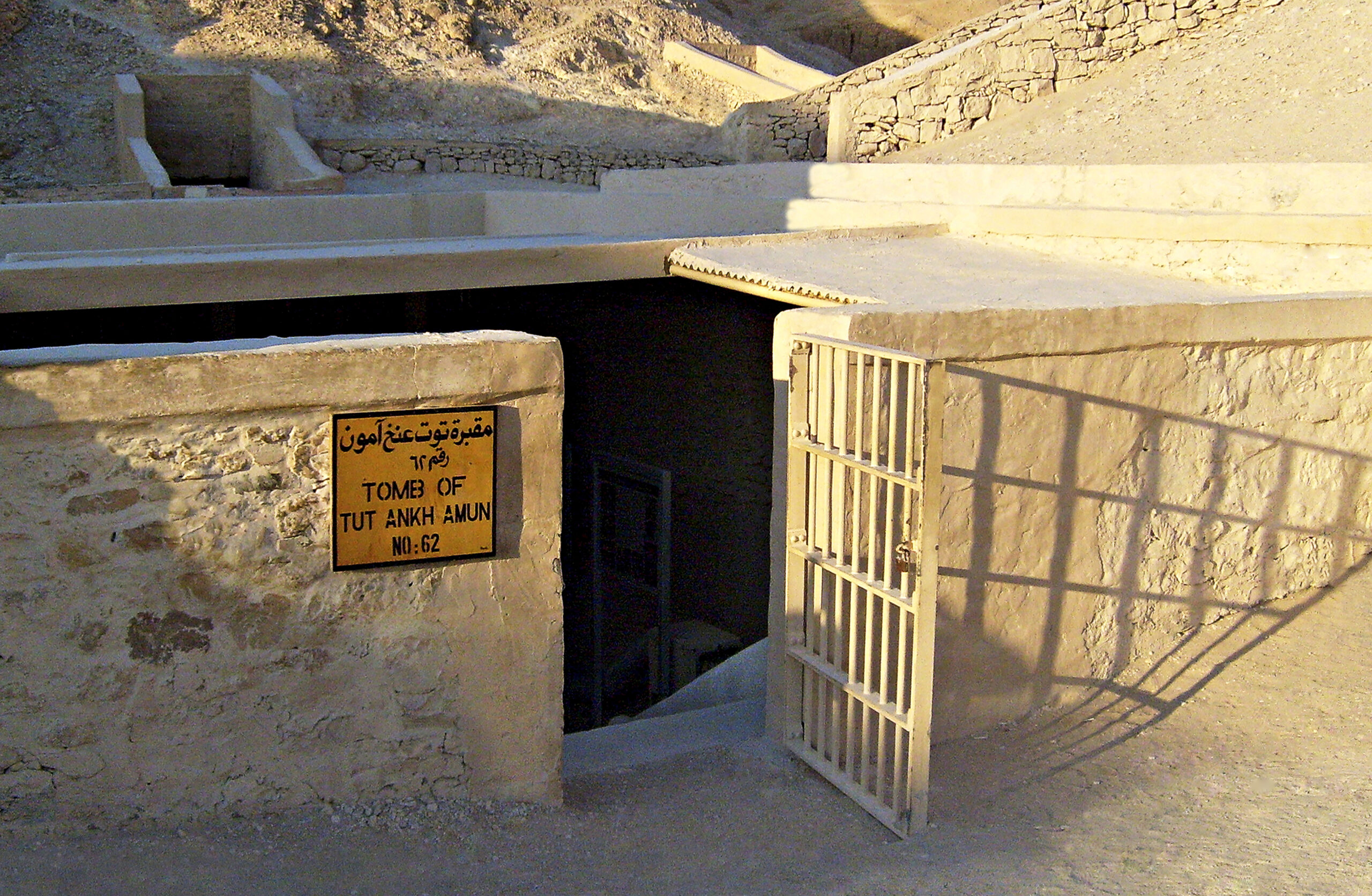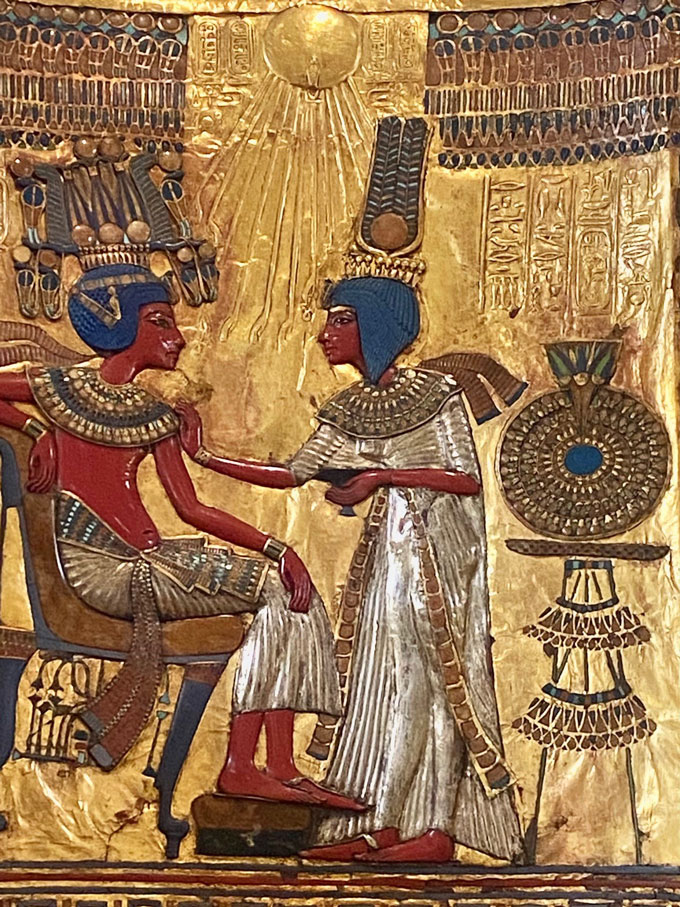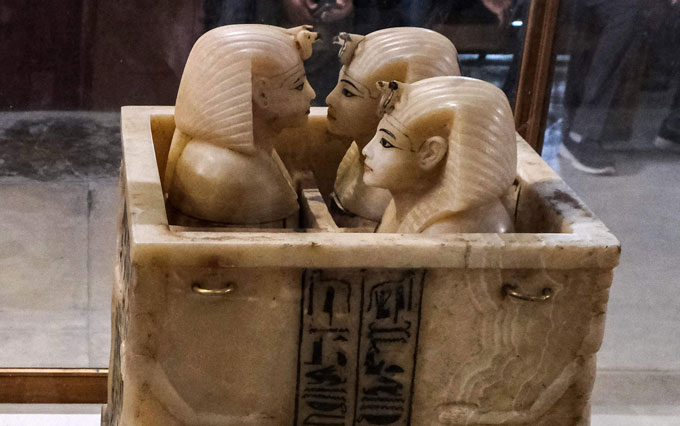King Tut’s tomb still holds secrets 100 years after its discovery
The story of this ancient king, whose tomb was uncovered in 1922, is still being written

This is the first of King Tut’s three nested coffins.
MOHAMED EL-SHAHED/AFP via Getty Images
Share this:
- Share via email (Opens in new window) Email
- Click to share on Facebook (Opens in new window) Facebook
- Click to share on X (Opens in new window) X
- Click to share on Pinterest (Opens in new window) Pinterest
- Click to share on Reddit (Opens in new window) Reddit
- Share to Google Classroom (Opens in new window) Google Classroom
- Click to print (Opens in new window) Print
By Bruce Bower
One hundred years ago, archaeologist Howard Carter made a historic discovery. He stumbled across the long-lost tomb of ancient Egypt’s King Tutankhamun. King Tut, for short. Until then, few people knew the name of this ancient boy king. But Carter’s find made King Tut the most famous of pharaohs.
It all started on November 4, 1922. Carter was leading a team to explore Egypt’s Valley of the Kings. Many ancient pharaohs and nobles are buried there. Carter’s team found a step cut into the valley floor. By November 23, the crew had uncovered stairs leading down to a door. Ancient Egyptian writing on that door identified what lay beyond: King Tut’s tomb.
Tutankhamun rose to power around 1334 B.C. At the time, he was about 10 years old. His reign lasted until he died around age 19. King Tut was not seen as a very important pharaoh in ancient Egypt. But his tomb makes him special to modern archaeologists. It is one of the few ornate pharaoh burial places found largely intact.
Carter organized a 10-year project to document, conserve and remove more than 6,000 items from the tomb. Some objects, like Tut’s gold burial mask, are now iconic. Other artifacts include musical instruments, hunting equipment, jewelry and chariots.
With such a trove to pore over, it’s no wonder scientists are still learning new things about King Tut. Here are three surprising things to know on the 100th anniversary of his tomb’s discovery.
@sciencenewsofficial A century after its discovery, King Tut’s tomb is still revealing secrets. #kingtut #Tutankhamun #archaeology #science #learnitontiktok
♬ original sound – sciencenewsofficial
1. Tut may not have been frail.
King Tut is known for being a fragile young man who limped on a clubfoot. He got this reputation because some CT images seem to show his left foot is deformed. Plus, he was buried with more than 130 walking sticks.
But “recent research suggests it’s wrong to portray Tut as a fragile pharaoh,” says Bob Brier. A mummy researcher, this Egyptologist is an expert on King Tut. He works at Long Island University in Brookville, N.Y.
Ancient Egyptian officials were often depicted with walking sticks, notes Brier. Those staffs, he says, were signs of authority, not frailty. Plus, researchers don’t agree about whether images of Tut’s bones show serious deformities.
Other clues from King Tut’s mummy and tomb also hint that he might have been physically fit. He might even have fought in wars. Tut was buried with military chariots, leather armor and archery equipment. Those items suggest the young king wanted to be viewed as a hunter and a warrior.
What’s more, inscribed blocks from Tut’s temple show the pharaoh leading soldiers in chariots into battle. The inscriptions do not include dates for the battles. But if more blocks turn up showing battle scenes with dates, it would hint that Tut was in those conflicts, Brier says.
2. Tut’s initial obscurity led to his fame.
After King Tut died, ancient Egyptian officials did their best to erase historical references to him. That was because his father, Akhenaten, had taken actions that turned his people against him. The older king did this by banishing the worship of all Egyptian gods except one. Egyptians who had prayed to hundreds of gods suddenly could worship only Aten, the sun god.
When he banned such cherished religious practices, Akhenaten met so much resistance that he moved to an isolated city. There, he lived with his family and around 20,000 followers. After he died, the city’s residents returned to their former homes. Egyptians reclaimed their old religion. And Tut became king. But he inherited his father’s bad reputation.
Later pharaohs did not mention Akhenaten or Tut in written records. Tut’s tomb was treated just as dismissively. Nearly 200 years after Tut’s death, craftsmen working on the tomb of King Ramses VI built their huts over the stairway that led down to Tut’s far smaller tomb.
Carter found evidence that the boy king’s tomb had been entered twice after it was sealed. But whoever broke in took no major objects. King Tut’s public disgrace and unimportance may have saved him from tomb robbers, says Kara Cooney. She’s an Egyptologist at the University of California, Los Angeles.

3. Tut’s tomb was a rushed job.
Pharaohs usually prepared their tombs over decades. They built many rooms to hold treasures and ornate coffins. But King Tut died too young for that. There was no time for such long preparations. Plus, Egyptian traditions required laying a mummified body in a tomb about 70 days after death. That window gave craftsmen little time to finish crucial tomb items, many of which required a year or more to make.
Such burial objects include a carved stone sarcophagus (Sar-KOF-ah-gus) that held three nested coffins. Also, Tut’s tomb was supposed to hold four shrines, hundreds of servant statues, a gold mask, chariots and jewelry. An especially important piece was a chest that contained four mini gold coffins. These held the king’s internal organs that were removed when he was mummified.

Workers seem to have taken many objects for Tut from other people’s tombs. These included the young king’s throne, the three nested coffins and shrine, and tiny coffins for his organs, says Peter Der Manuelian. He’s an archaeologist at Harvard University in Cambridge, Mass. Even cutting those corners, time ran out.
Consider the sarcophagus. Two of four goddesses on the stone container lack fully carved jewelry. Workers painted on missing jewelry parts. Carved pillars on the sarcophagus also are unfinished. There’s also the sarcophagus lid: It’s granite, which doesn’t match the quartzite bottom. Something must have happened to the original quartzite lid. Workers carved a new lid from available granite and painted it to look like quartzite. But repairs on the new lid show it broke in half during the carving process.
“Tutankhamun was buried with a cracked, mismatched sarcophagus lid,” Brier says.
Some researchers think that Tut’s hasty burial place was not even meant for him. One who feels that way is Egyptologist Nicholas Reeves. He works at the University of Arizona in Tucson. Reeves argues that Tut’s tomb was meant for Nefertiti. She was the wife of King Tut’s father. Reeves thinks she briefly succeeded Akhenaten as Egypt’s ruler, until Tut became King.
No one has found Nefertiti’s tomb yet. But Reeves predicts that one wall of Tut’s burial chamber blocks access to a larger tomb where she lies. Painted scenes and writing on that wall depict Tut doing a ritual on Nefertiti’s mummy, he says. And the style of those paintings was used only years before Tut’s burial.
Reeves’ hunch is intriguing. But four of five remote sensing studies done inside Tut’s burial chamber show no evidence of a hidden tomb. So, the question of who this burial space was truly meant for remains a mystery.








